#horizon meta
Explore tagged Tumblr posts
Text
After spending the whole weekend grumpy and ruminating about Burning Shores, I think I finally figured out what has me so bothered about Aloy and Seyka's relationship. I wasn't gonna post anything about it beyond the one salty post because nobody needs to hear me go on and on about what's essentially an "I don't wike it" complaint. But the more I thought about the more I started to realize that my problem with Burning Shores is tied to the one big problem I have with Horizon as a whole, which is that Guerilla really seems to struggle with balancing Aloy's position as the protagonist and letting companions shine as characters of their own who can go on quests with Aloy without being useless or getting in the way (or both! too often both!).
I care about the gameplay mechanics less than the writing because the gameplay stuff seems more like level design growing pains than anything else. And we have examples of it being done quite well to (Varl in the tutorial portion of Forbidden West) annoying (here's looking at you Cauldron in Frozen Wilds) or, well, useless as combat support (always, in my experience, with the exception of how it was handled in Zero Dawn's final battle). However, I wouldn't have as much an issue with this gameplay fumble if it wasn't for the impression that the narrative wants me to believe Seyka is somehow immune to it. Or more of an equal to Aloy in terms of ability and responsibility than anyone else, which is just not the case. Everyone plays third fiddle to Aloy because Horizon doesn't actually have a party system! There's nothing special about Aloy and Seyka taking turns with a ballista, or whatever. Seyka was still surplus during combat, or straight up in my way, just like everyone else. That said, I don't know if the experience is different in higher difficulties because I play strictly on story mode, so make of that what you will.
So the writing. It actually pains me a little bit to write this because I love Horizon's story so much (and this should tell y'all something because I detest what if AIs were people plots). I love the characters and I absolutely am bonkers for its worldbuilding. No other game has made me cry as much or be as angry (fuck you, Ted). Yet, sometimes the characters do fall a little flat when they interact with each other. Conversations between Aloy and NPCs often don't flow well from one topic to the next, and they can end abruptly too, in a way that goes beyond the Aloy's conversational skills. The pacing is a bit wonky, too, in how quickly bonds develop or transition. Not that this is always the case since there are some great characters moments, and I also think introducing the Base was a solid step in making everything feel more cozy and believable. I guess what I'm trying to say is that too often I feel I'm being presented relationship concepts, but not being given the time to let those relationships develop organically. Perhaps also a case of growing pains; it just sucks that a game so well put together narratively can struggle with something so central to its interests.
But anyway, this post is actually about Burning Shores and why the whole romance subplot with Seyka and Aloy was so...bland to me. The problem lies primarily with how Seyka was conceptualized as character-- or, well, how it comes off: she really seems to have been created to be Aloy's love interest first, and a character in her own right second. It's like Guerilla just asked themselves what would make a great love interest for Aloy and, though the answer was someone who can keep up with her, they ended up careening straight into Aloyx2 with a Seyka veneer, and not much else.
Seyka is a great hunter and warrior, she bucks tradition to stand for what's right, she's kind of an outcast now, she has sister issues! She got herself a focus she wasn't supposed to have and it made it really hard for her to fall in line with the Quen's social structure! They even rappel the same! But who IS Seyka outside of Aloy and wanting to be with Aloy? How IS she affected by so suddenly stepping outside of her social role? She seemed to have been quite comfortable in it before, so how much is she struggling, really? How is her experience different from Aloy's since Seyka wasn't actually ever an outcast (and I mean the Admiral was in her corner the whole time). Did she have other ties to the tribe beyond her sister?
I don't know, guys, for a character that was meant to be so central to Burning Shores, I came out of the game knowing precious little about her. And as a result, there's a complete lack of tension between her and Aloy, and it'd be so easy for it not to be the case! Even their banter is more like stock competitiveness than anything interesting, which was a missed opportunity because there was an alternative to that was just begging to be leaned into more: Aloy didn't have to be the serious one for once! Their banter as the player explores Pangea Park was such a fun variation of usual commentary. Plus, Aloy's "miss me?" line when she comes back from exploring on her own was super cute. But to make their relationship compelling, Seyka would've needed to be her own person first, rather than a collection of Things She Has In Common With Aloy.
To make matters worse, what the narrative tells me is special about Seyka and Aloy's relationship isn't so special after all when it's echoed across Aloy's relationships with several other characters. How many times to we see characters be more than capable to hold their own in a fight alongside Aloy? How many characters are also shown to be smart enough to keep up with her? And how many characters are trying SO HARD to share Aloy's burden with her? Or who could share common ground with some of the things Aloy struggles with? And all the while, these characters are all very distinct not only from each other, but from Aloy herself and their dynamic with her. If Seyka is more successful than they are, well, why is she? And why aren't they? Because the plot demands it isn't really enough of a reason when you're shooting for character-driven storytelling.
Of course, it just adds insult to injury that the whole relationship develops in the span of what a month? At most? So that scenes like Aloy comforting Seyka halfway through the DLC don't seem like's it's been earned. It might have been a better bet to have swapped Seyka and Alva's introductions to the story. It's worth noting, too, that I only care so much because I'm not convinced Seyka is just a summer fling, so she really did deserve more than a speedrun of finding love during summer camp.
On a much much smaller note: I do feel a certain way about how other potential love interests kind got exited pursued by bear during Forbidden West too with Telanah (bisexual people exist, do not come to me talking about comphet) and Varl getting love interests of their own, and Nil becoming even more of a side character lolsobs Nil HZD you will always be famous to me.
I very much hope H3 does more for Seyka because as it is I'm so not invested it's not even funny. I also live in fear that the line from the Pangea movie about coming back because the love interest is home is gonna feature in some way in their reunion and it's Not Gonna Be Convincing. Incidentally, let nobody tell you writing romance is easy.
Secret good Seyloy that exists in my head save me, etc.
And, frankly, I know people like to rebuke some criticism of Horizon with "this isn't a BioWare game," but Guerilla could do a lot worse than taking point from Dragon Age and Mass Effect in how they handle companions.
#horizon forbidden west#burning shores#horizon#horizon meta#hoping i have now exorcised this sulk from my soul and can go back to vibing#my writing#long post
8 notes
·
View notes
Text
Power in a Name: Nil and Aloy parallels
I've been thinking about the inverse parallels that Nil and Aloy have with social dynamics with their names, and how it gives them a level of understanding that is completely unique to them and how they regard each other. It's something that is unspoken between the two of them, and yet mutually understood, and it gives a level of emotional depth that is immensely cathartic upon the acknowledgement of each other by name.
**spoiler discussion for Horizon Zero Dawn and Horizon Forbidden West**
---
Aloy has only ever wanted to know her mother's name; there's connection and lineage and community in the name of your family. For so much of the "tutorial area" in The Embrace and the events leading up to the Proving, her name is not important to identifying her: she is simply known as "motherless" or "outcast" or both. Lansra wants to deny her even being given a name during the opening cutscene -- it's only through Teersa's kindness and calm, firm insistence that she be named facing the sunrise with a Matriarch's blessing.
Across the games, Aloy is given a number of titles from the various tribes: Anointed of the Nora, Savior of Meridian, Hekarro's Champion. All these titles laud her accomplishments and put her on a pedestal of respect; the complete opposite end of the spectrum to when she first interacts with the tribes.
To the Nora, she has gone from the lowest social status in the tribe as an outcast, to Anointed in one fell swoop-- given a sacred status of near-worship and unquestioned acceptance due to the belief that she has spoken directly to All-Mother within the Mountain. This sudden switch is so jarring for her, and also a stark realization that while she thought she was looking for acceptance, she never wanted it like this.
The Carja have always held arrogant views on the other tribes; their advancement in technology and their organized militarization have given them a distinct advantage over all the other tribes, and with it, a sense of superiority. Their culture and their religion reinforce the idea that the Nora are simply savages, with the upper classes seeing them unfit to even deign faux-civil conversation (as seen in the Hunter's Lodge). In the face of the oncoming destruction led by HADES and the Eclipse, Aloy's victory is seen as heroic and put onto both a figurative and literal pedestal in a display of zealous admiration for her accomplishment at slaying Helis, Terror of the Sun, and saving Meridian from certain doom.
The Tenakth, viciously protective of their land and people, are already disinclined to allow outlanders to walk their Clan Lands in the aftermath of the Red Raids. Fashav tells us that without proper right of passage the Tenakth would attack Aloy on sight, no questions asked, regardless of the importance of her mission. Following the Embassy, the events at the Bulwark, and the defense of the Kulrut, Aloy quickly gains a fearsome reputation and accompanying moniker of Hekarro's Champion -- again, a title of her accomplishments.
Throughout all of her journey, she does her very best to be known by her own name, not by any grand title or reputation of great renown, but simply as the huntress Aloy. She rebuffs most greetings of her monikers with "Just Aloy." in a clear and direct attempt to be met as a person instead of by the sheer force of her reputation as told by others.
So much of her life has been under the weight of other people's perceptions of who they think she is: a larger-than-life-figure, a mysterious huntress with second sight, a formidable warrior even by the standard of great warriors. Even her perception of herself in shadowed by the width and breadth of Elisabet's legacy and sacrifice. Is it too much to ask for her to simply be seen and known as herself, and just as that?
---
Nil, conversely, has been known by many names, most of his own choosing. Names are evidently important to Carja culture, as many have epithets or titles to indicate their standing or calling, like Mournful Namman, Studious Vuadis, Javad the Willing, or Well-Traveled Aram. Nil seems to shed names as easily as Aloy does armors, changing and adapting and letting go of past personas quite easily. A name to the Carja is connection, power, and reputation. As we meet Nil, he introduces himself and is then known by a name of his own choosing: one that literally means "nothing". Every name we know him by is one made to embody a new persona, with no connection to his lineage.
Upon first meeting, he introduces himself by telling Aloy to "…call [him] Nil." Notice the wording: "call". Not "My name is…" His phrasing is distinct and deliberate, and majority of the conversation you have with Nil after completing the Devil's Thirst bandit camp is vague in terms of his origins, skirting around clear details and speaking in obfuscated references to past events. Through Janeva, Warden of Sunstone Rock, we learn that "Nil" is not his first name, although it remains uncertain if he was known by his true name or another during his time at Sunstone.
ALOY: Do you know a…hunter…named Nil? He told me about this place. JANEVA:Nil? That’s what he calls himself now? Is he well?
2. To the Carja, he is known by reputation and rumour, war stories and whispers; renowned enough that he is recognizable by common Carja Guard, and feared enough that they do not speak his name. It is likely he was given some kind of moniker or a name of near-boogeyman-like status, given the prayer of protection the guard mutters after Nil offhandedly addresses them.
CARJA GUARD 1: Isn’t that…him? From the battle of the Daunt? CARJA GUARD 2: Can’t be. Cinnabar Sands was before that, and there were no survivors. NIL: Well, I don’t like to boast. CARJA GUARD 2: O Sun, keep the shadow from falling upon me.
He knows his reputation carries further than where he walks, and while he acknowledges its connection to him, he still would prefer to be somewhat removed in its association, of the elaboration and hyperbolic storytelling of past deeds and, perhaps, misdeeds.
3. Addressing the animosity held by the neighbouring tribes from the events of the Red Raids, there is one tribe Nil holds to a status of respect and equal regard: the Tenakth. He highlights a kinship and mutual understanding of the need for a fight and the desire of spilled blood; one that Fashav echoes as well:
"As you may have noticed, violence is the native tongue of the Tenakth. To survive, one must master it."
He sheds the skin of Nil the Bandit Hunter for Red Teeth the Racer, to meet the Rebel defectors on equal ground, to fight for respect on their chosen battleground the way Tenakth warriors of the past had fought their way into his respect with their martial prowess and skill. The name he gives them is, again, one he chooses, with no obvious attachment to the past, only embracing the change and growth that is to come with reinventing yourself. Nil chooses to be perceived by the world in a way that is not derived from or reliant on his family name, the heritage that comes with it, or the socio-cultural weight it carries to be recognized as Carja.
---
Aloy is given many names by the tribes and people she meets on her journey, but only wants to be known by her own name, to know her own heritage and lineage. In seeking that out, she is both empowered and staggered by the knowledge, and it changes her perspective on who and what she feels she has to live up to -- her tribe's expectations, her predecessor's hopes and wishes for the future world, her own expectations of herself. In the face of that knowledge, she doesn't leave herself the room to consider herself, but still wants to be acknowledged as an individual. Nil does so, and savours the knowledge of her name like a gift:
ALOY: …Nil? NIL: Aloy. They told me your name, I said hair like a splash of blood, tenacious as a Scrapper’s jaws. [Main Quest: The Looming Shadow]
Nil gives out new names to be known by --names of his own choosing -- in an act through which he is deliberately shedding the weight, status, and legacy of his birth name, leaving it behind. Instead, he transforms into a different version of himself, one unburdened by birthright and tribal ties.
RED TEETH: That was a well-earned win. One that merits speaking face to face. ALOY: Nil?!? NIL: You have to admit, I put on a good show. [The Stillsands Gauntlet race, Condition: Win]
Nil knows implicitly that he can share this secret with her -- the secret of his identity as Carja, a danger in hostile Tenakth Clan Lands. And Aloy still trusts him, still respects him, to keep his secret, even with the secrecy of his bloodied history hanging in slight tension with the circumstances and the environment he's found a home in. Even so, she still calls him by the name he asked to be called by:
ALOY: I’m glad you found your thing, Nil. Relieved, actually…I think.
And what a catharsis it is, then, to be known and recognized by the name you yourself value, by the only other person who could understand the weight and power in a name:
NIL/ RED TEETH: I’ll leave you to it. See you when you feel the need, Aloy.
#cor writes#cor's meta analysis#horizon zero dawn#hzd#horizon forbidden west#hfw#aloy#nil#hzd nil#hfw nil#horizon meta#no i will never shut up about this#they're parallels ���� they're character foils 👏they're narrative reflections of each other👏#there's power in a name and names have power#but that's also another meta i will get to eventually
82 notes
·
View notes
Note
re: your post about quen glyphs... it's possible that the old focuses they found in the delta were formatted to work w/ simplified chinese characters... after all, the focuses are pre-zero dawn and would have been formatted to whatever the local ppl used, right? its even possible that being able to write and speak simplified chinese in addition to any other languages that a focus could be formatted to might be something on the diviners examinations alva talks about... (also the fascinating implications that the quen might have had the only record of other languages existing pre-apollo)
I'M SO SORRY IT TOOK ME SO LONG TO REPLY TO THIS. But I wanted to do it when I had time and brainpower to fully think it through 😂
So this ask is in relation to my tags on this gorgeous photo, where I remarked that it's weird for this beautiful Quen person to be carrying a tablet with what look like nonsense glyphs, when we know canonically that the Quen read and write English in the Roman alphabet. This is in contrast with the Oseram, for instance, who read and write English in their own original glyph system (as evidenced by Erend having trouble learning to read the Old Ones' glyphs).
For the purposes of this reply, I'm going to focus on Mandarin and Cantonese as the spoken forms of "Chinese" since they're the most familiar Chinese languages, and since Mandarin is considered the "standard" Chinese language. Before I start, I should also point out that there is no such thing as spoken simplified Chinese; "simplified Chinese" refers to a variation of written Chinese that's usually used to transcribe the spoken language of Mandarin, whereas "traditional Chinese" refers to the written variation of Chinese that's usually used to transcribe Cantonese.
ALSO, STRAP IN, BECAUSE WE'RE GOING TO GET A LITTLE NERDY HERE. I'm a speech-language pathologist by day (smut writer by night! 👹) and my favourite class in undergrad was a course about writing systems of the world, so I'm just giving advance warning that YOU ASKED FOR THIS. 😂😂😂
Okay, diving in now! That's a really good point re: the Focuses in the Great Delta -- it would make sense for many of the Focuses there to be set to display in Mandarin and/or Cantonese, and thus for the "glyph system" to be simplified or traditional Chinese characters, respectively. But if we're sticking to canon lore, the Quen don't speak other languages. There is a datapoint from Alva about this where she expresses some (VERY ACCURATE AND ADORABLE) disgust at Ted Faro for the loss of all languages except the Zero Dawn "default" language of English. If we're taking this at face value (and I see no reason why Alva would lie about this in her notes), then even if the Focuses were formatted to display Chinese characters, the Quen wouldn't be able to read them. This would also explain why being a Diviner is a rare and highly-prized role: it would probably be rare for the Focuses they found to be set in English, and those English Focuses would be even more prized and revered since they're interpretable.
Now, we might wonder why the Quen wouldn't be able to learn to speak Mandarin or Cantonese by deciphering the glyphs on a Chinese-formatted Focus. The problem is that the Quen have no spoken language to map the Chinese characters onto. Chinese characters are not an alphabet, and thus there's no one-to-one correspondence between a character and a sound or a sequence of sounds; instead, Chinese characters are largely morphographic, meaning they represent a unit of meaning rather than a sound or a sequence of sounds. The Quen might be able to figure out what some Chinese characters represent by comparing a single piece of text that's written both in Chinese and English, but they would not be able to figure out what the Chinese characters sound like.
Ah, but you might be wondering if the Quen could have figured out how to speak Mandarin/Cantonese by listening to audiorecordings or holovids in Mandarin/Cantonese and mapping them to transcripts written in Chinese, then comparing those Chinese transcripts to English transcripts of the same text? (Wait, YOU'RE NOT WONDERING THAT? SERIOUSLY?? I'm teasing. I'm clearly overthinking this.) I mean, yes, they could, but that would require you to have a piece of text in both English and Chinese that also has a corresponding holovid/audiorecording in Mandarin/Cantonese for that text, which... I mean, maybe I'm wrong, but that seems like a pretty big ask. Then again, if the Focuses have like a library of C-dramas with subtitles, then that could work???
But this brings me back to Alva's datapoint again. If all of the Diviners learned Mandarin/Cantonese for their exams, either Alva is being secretive about this in her own notes (seems implausible to me, she is not a disingenuous person), OR there is a faction of Quen Diviners above Alva's proverbial "pay grade" who are working on that. So that could be an interesting avenue for someone to explore in fic! Actually, the more I think about it, the more plausible it seems that there is some "upper class" of Diviners who are secretly working on restoring old languages and who get extra perks from the Imperial family for interpreting the most valuable texts. Okay, you got me, you talked me into it LOL.
But let's return now to my original cheeky remark re: the Quen glyphs as pictured in the game. This is a more detailed image of some Quen glyphs in Burning Shores:
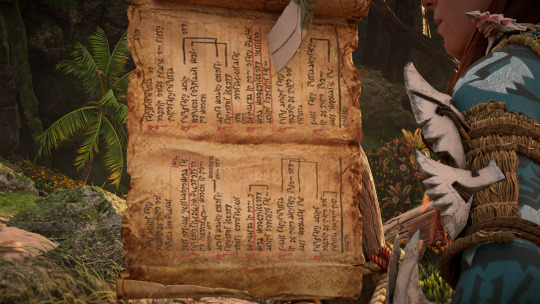
Now, we can't say whether this piece of text is meant to be read top to bottom or whether it was pinned to the post sideways, but it looks to me from the brackets and the red lines (likely underlines) that it's posted sideways and is meant to be read either right-to-left or left-to-right. This does not look like Chinese characters, either simplified or traditional. On a superficial inspection, it looks to me more like the Tibetan syllabary, or maybe the Hebrew abjad, without actually being either of those. In the image I referred to at the beginning of this post, the glyphs look more like the Arabic abjad as it would be used to transcribe Farsi. In other words, the Quen glyphs as pictured in the DLC alone are inconsistent.
To be perfectly honest, I think that these Quen glyphs are a "game-ism": one of those things that's a visual element in the game that actually doesn't match up with the lore, similar to how Grudda is canonically from the Desert Clan but has Lowland tattoos. (If you've never noticed this, I implore you to use tearblast arrows to blow off all his armour until he's naked down to his underoos the next time you play LOL. Drakka would greatly approve.)
In short, I still adhere to the idea that the general Quen population read and write in English using the Roman alphabet, and that the Quen glyphs pictured in these images are visual nonsense (NO OFFENSE). If there are any Quen who speak and read in other languages, it would most likely be a secret faction of Diviners that Alva doesn't know about.
I hope this answer was satisfying and not fucking boring as hell BAHAHAH. Thank you for making me think about this, though! It also reminds of a mini-rant I have about Hekarro wanting the Tenakth to learn Carja glyphs that I should find some time to write out!
If anyone has further thoughts about this, feel free to comment/reblob/send me an ask or a message or whatever! ❤ Also, forgive any typos, it's past 1AM when I'm writing this LMAO.
-- much love from your friendly neighbourhood Pika xoxo
#horizon forbidden west#hfw#horizon burning shores#burning shores spoilers#horizon meta#is that a thing? IT IS NOW#pikapeppa talks#quen#alva#alva hfw
29 notes
·
View notes
Text
the thing I keep coming back to at the end of the day here is that luffy’s got some insane latent abandonment issues, and zoro and nami are the absolute surest thing he has. he has those two Locked The Fuck Down so hard he might as well have put a ring on it before they even hit loguetown and he knew they’d be his from the second he saw them. they’re his aces in the hole that he can always count on to help him cut through all the bullshit and get to the heart of the situation. something that always stands out to me is the way that when luffy and zoro end up tied up in a combat situation, it often falls to nami to direct and organize the crew (most notably in water 7); they’re his seconds in command, one to back him up on the battlefield and one to hold down the fort so he’s free to fight as he pleases. and in return for this faith and trust nami and zoro are genuinely the most obsessively devoted motherfuckers they’re capable of being! none of their dreams belong to just them anymore it’s THEIR dream to make luffy king of the pirates, THEIR dream to map the world, THEIR dream to become the best swordsman. frankly if they all loved each other any more than they do they might just burst
#one piece#I literally cannot ever stop thinking about how they never fucking doubt each other. not when it matters. they’ll all always come through#btw nami does end up calling the shots surprisingly often when you keep track of it#romance dawn trio#my like. rule for them ig. is nami watches the road. zoro watches their backs. and luffy watches the horizon#logistics protection and purpose if that makes sense#op meta
213 notes
·
View notes
Text
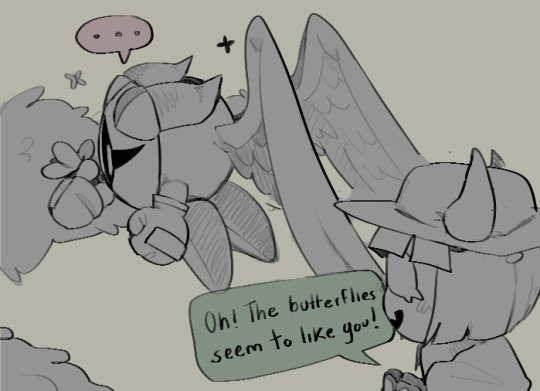

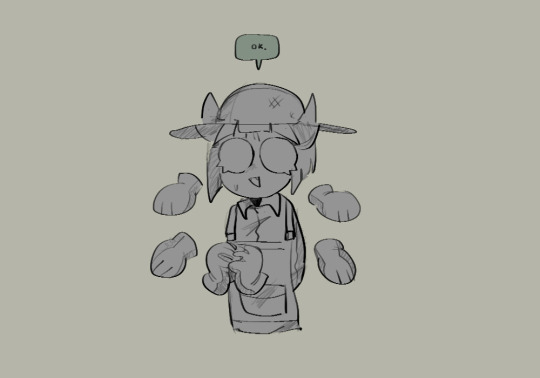
Bonus piece from this art
#kirby#kots#kirby of the stars#kirby fanart#hoshi no kirby#Taranza#Galacta Knight#Galacta doesn't know how to go about life without being mysterious#the difference between Galacta and Meta Knight is that Galacta is quiet and mysterious by nature#meta knight does it on purpose to appear cool#Taranza is trying hard not to judge#I think he gave up on trying tp understand#Galacta is mostly quiet but sometimes goes into these monologues while looking at the horizon and Taranza politely listens#Galacta is like 'I've been through so many lifetimes and relived my death time and time again and yet trusting is my demise'#and Taranza is just like 'sure'#Taranza just appreciates the companionship while he's gardening it's like listening to youtube while you draw#you didn't understand half what you just listened to but at last it feels like you're not alone#I'm not sure how to free Galacta Knight in my au yet#but i know they can't fight or they risk to go back to their crystal#that's a rule mentioned in the novels and we don't have tons of those in Kirby canon I'll take what I can get#so instead of fighting they take on gardening isn't that nice#Galacta probably arrived at Dreamland first (Because of course they do) and Dedede doesn't want to deal with them and just sends them away#they probably live temporarily with Kirby because in the novels Kirby actually likes Galacta a lot it's their kin#enough talk about backstory this is supposed to be taken at face value#but Galacta and Kirby would be besties and probably the first person Galacta trusts in basically forever#Galacta would HATE magolor#that's all im going away im so sorry im autistic
599 notes
·
View notes
Text
Kirby Town Tunes
A collection of town/island tunes for Animal Crossing based on assorted tunes from the Kirby series. Screenshots are for New Horizons, but they should work in any Animal Crossing game.
Running Through the New World from Kirby & the Forgotten Land
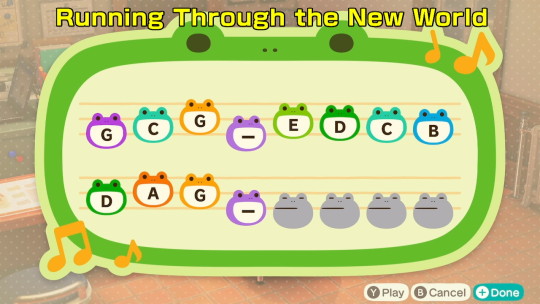
My Friend and the Sunset from Kirby Super Star

More under the cut for ten total
Planet Popstar from Kirby 64

Grass Land from Kirby's Epic Yarn

Mt. Dedede from Kirby's Dream Land (also just Dedede in general)

Boarding the Halberd from Kirby Super Star

Castle Lololo from Kirby's Dream Land (also associated with Dynablade) albeit based more on the Super Star Spring Breeze rendition

Frozen Hillside from Kirby Air Ride
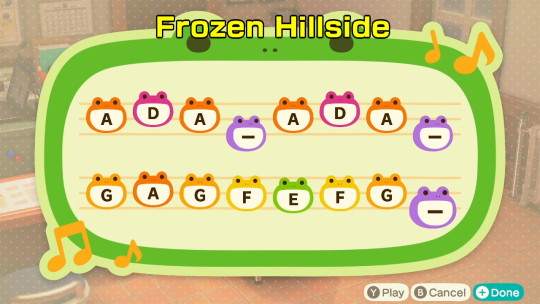
Bubbly Clouds from Kirby's Dream Land

Wind Blowing on Earthfall from Kirby Star Allies (ending is a bit truncated here)

#animal crossing#animal crossing new horizons#ACNH island tune#acnl#acww#animal crossing wild world#animal crossing new leaf#kirby#Kirby's Dream Land#kirby 64#kirby super star#kirby's epic yarn#kirby air ride#kirby and the forgotten land#kirby star allies#meta knight#king dedede
299 notes
·
View notes
Text
back on my Horizon deep-thinking. The idea of finally pulling the plug on Aloy having a gay relationship in a DLC set in LA and up against a villain who married a hollywood star.
Walter Londra represents the old world, old philosophies, old ways of thinking. Through his marriage, he gained another level of power via entertainment and emulating the perfect heterosexual romance (that was ultimately doomed).
Even the final boss itself is so bombastic and grand that it wouldn't be out of place in a blockbuster.
The thing that beats Londra, who represents the old world, and old hollywood as an extension, is a mixed-race lesbian couple.
Now that's what I call gay propaganda.
43 notes
·
View notes
Text
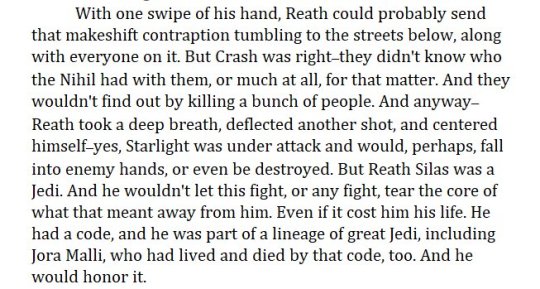
JEDI LINEAGES ARE NOW A THING IN CANON???? (Star Wars: The High Republic: Midnight Horizon)
162 notes
·
View notes
Text
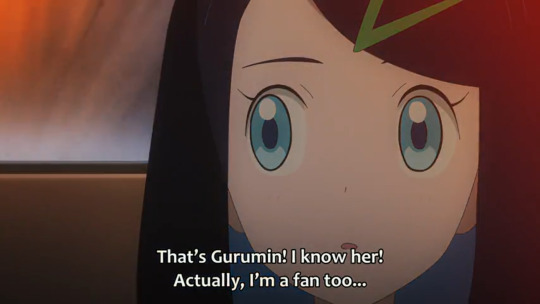

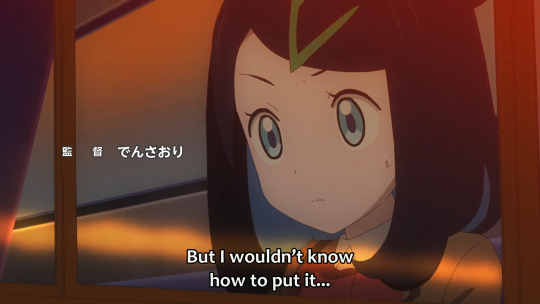
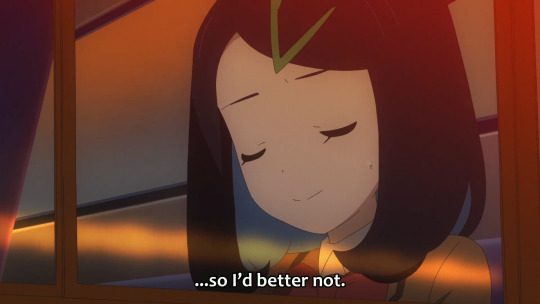


I love how they've already given Liko an internal conflict that's so different from not just Ash, but most protagonists we've had in Pokemon so far. We've had characters be nervous before, and who've had difficulties socializing in their past, but I don't think any of them responded to it the way Liko does.
She's not super animated when it comes to her anxieties, either, which is kind of refreshing in a way. I feel like there's a tendency to make these sorts of characters so loud and obvious about their fears that it sometimes becomes comical, and while I don't have an issue with that, it's nice to see this more grounded take on it, too.
Because like... anxiety isn't always visible. Liko clearly has a lot going on in her head at any given moment, but she doesn't outwardly express herself very much. And as a result, people reportedly have a hard time understanding her.
And that's just really cool to see in the protagonist of this kind of series - one that has such a bright, loud energy to it. Sure, Liko will probably develop to have a similar energy to her, but her starting place is fundamentally different from what we've seen before, and that's exciting to see play out. I'm already looking forward to seeing more of her!
#pokemon#pokeani#anipoke#pokemon horizons#trainer liko#analysis#meta#There are more things that I like about Liko from the first episode but I'm leaving it there for now#Also I really want to spell it as Riko but the subs and whatnot are saying Liko so. I'll manage I guess
621 notes
·
View notes
Text
Unhinged animal crossing rabbit hole.
ive been playing animal crossing new leaf again, because as dope as new horizons is the villagers feel a little flat in comparison with past games.
Anyway, i've fallen into a strange rabbit hole of like. villager identity politics. they clearly self identify with their own species (a peppy villager in new horizons will mention a "fashionable [species] monthly" magazine. In the original game, tom nook will mention a "mammal strike" when calculating the debt for your first home loan, and Hopkin's photo quote says something alone the lines of "a wise mammal avoids danger". Are there like. taxonomic based class structures. Is biological essentialism a right wing talking point - also, almost every business is owned by a mammal, with the exception of really only the Roost (i'd argue that the museum is a not for profit) and maybe Club Lol, but Dr Shrunk did have to come begging to the mayor to get signatures so...
Are semi-aquatic villagers like octopodes and frogs oppressed?? is there equal representation for non-mammalian constituents??? The only interspecies romance we see in game is Lottie's (otter) crush on Digby (dog) in happy home designer - all other couples (Kapp'n and Lelani, Reese and Cyrus, whatever is going on between Pete, Pelly and Phylis) are between the same species. I think villagers, in older games, will talk about rumours of one villager having a thing for another but I can't find any dialogue dumps so I can't find any evidence of this.
Also! You as a human - at least the lazy (or maybe smug?) villagers will refer to you as their 'favorite human', so it's probably not taboo to mention species at least. In the gamecube game your mother questions why you'd even want to live with animals - "don't they smell bad?" so there is clearly discrimination between species, even if its not at an institutional level. Also - all of (most of, but like - thats all representative stuff) the museum artwork depicts real human painted artwork, with humans in it. Interesting aside - why does no-one know the correct name for the artwork? Why did some random guy get it on his boat with his other sketchy wears?
#Anyway#I'm firmly convinced the answer is 'its not that deep' and that the animal crossing games#should not be considered part of the same timeline#animal crossing#animal crossing meta#i guess#if this reads as unhinged rambling know it felt that way to type#if anyone can find a dialogue dump from *any* of the games older than new horizons#pls link it to me - i need to see if there is any other dialogue about this
62 notes
·
View notes
Text
In terms of what the mdzs novel ending leaves open and unresolved i don't think we talk about lan wangji enough.
Like. This is not lwj slander I love him but the novel pretty clearly sets it up that Xichen takes care of wangji more than the reverse. It makes sense, he's the older sibling after all. But lwj, for the rest of the story, is very much a guy whose priorities are wwx first wwx second and MAYBE you get to take third place if you're lucky. And he mourned Wei Wuxian for 13 years!! And he finally has him back! Of COURSE that's what he's gonna be like. But then as they settle into domestic bliss you see him have this uncomfortable realization that his older brother's been going through an incredibly difficult time, one reminiscent of the one he went through that his brother stood unflinchingly by his side for, and he... just wasn't there. He didn't even think about it, the realization only comes months later.
And to me that looks a lot like potential setup for a mini arc postcanon where lwj relearns how to care about and prioritize things and people that are not Wei Wuxian, a thing he can do now precisely because Wei Ying is safe and securely by his side.
With wei wuxian it's very clear for a reader to see that he has not wrapped things up with Jiang Cheng yet, he's got a burgeoning relationship with Jin Ling he'll want to work on, as well as catching up to do with Sizhui and Wen Ning once those two are done with their own little trip. He's a people person and that means he thrives when he's got lots of people he cares about around him! But lwj has spent the rest of the story in his "me and wei ying against the world" mentality and that ending sort of feels like a wake up call that maybe... it's not like that anymore? Not for everyone at least. There might be place for other people, too.
#mdzs#lan wangji#lan xichen#wei wuxian#mdzs meta#he's never gonna stop protecting wwx obviously. he might just broaden his horizon a bit.#this kind of arc is also the most likely way i could see lwj come around to... whatever the yunmeng shuangjie resolution would be#would he LIKE it? never#but i do think he could come to understand that yeah no these things are important even if they're messy and they hurt#because whatever that resolution would look like it's gonna be messy
340 notes
·
View notes
Text
You know what's funny about crosstaggers in this fandom? How it's almost never worth it to actually click on a jayvik or timebomb flagged post if it's in the caitvi tag.
They're almost always primarily a post about either ship, and caitvi was like, barely whispered over its contents and thus the poster believes it's something we here in the caitvi fandom are actually interested in.
Maybe one of them said hello once in their jayvikxreader fic or some shit. "Oh, I know! The lesbians sure would love to see this!"
Not really. I don't even dislike either ship. They're both fine, and when I'm in the mood for them, I'll go looking for them.
And I keep tapping on these flagged posts, thinking, "oh, maybe this one is actually about caitvi this time and the other ship is featur—oh. No. Again."
Which is on me, having hope that the crosstaggers are actually sharing content that's relevant to the tag they keep littering in.
They're not. They don't.
I just don't get it. It's leaking into AO3 too, and every day I keep wishing for a feature that would let us set a primary ship, but alas, instead I have to omit entire ships from my search parameters because no one understands that you don't actually have to literally tag everything if it's not in any meaningful quantity for the people who search or archive by that tag.
Just don't list them. It's pretty easy.
I can almost see why people are complaining that the other ships are 'overshadowing' Caitvi.
(In reality, I don't give a flying fuck who has the most posts/fics/art/whatever in a fandom. Ship, draw, write, and post about whoever you want.)
It's like, y'all are asking for irritated shippers to follow you back into your home tag to return the favor. This is literally how shipping wars are exacerbated. Instead you could just... not tag something that isn't truly relevant to your posts and we could all live in harmony.
And this isn't even touching the toxic haters for caitvi from either ship.
#caitvi#fandom bullshit#tumblr meta#please learn to tag properly#this isn't really rocket science#i'm far too old and exhausted to want to raid other tags#but as a Fandom Old(tm) i can see the beginnings of such things on the horizon
23 notes
·
View notes
Text



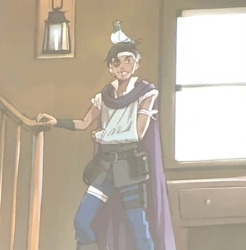

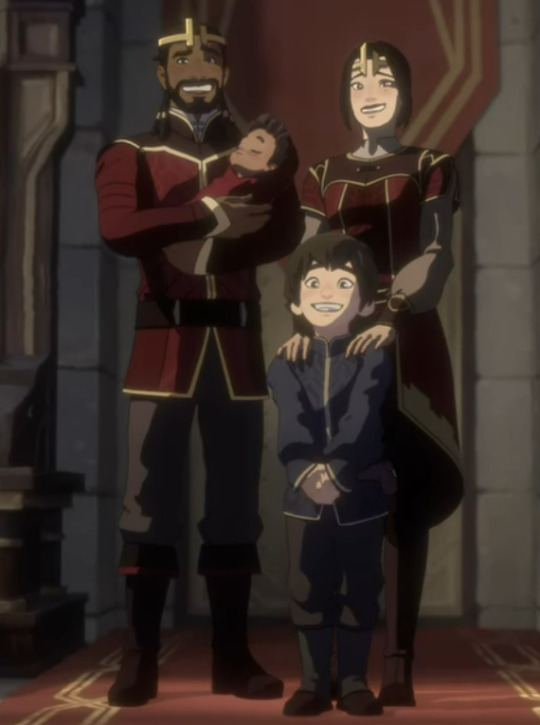

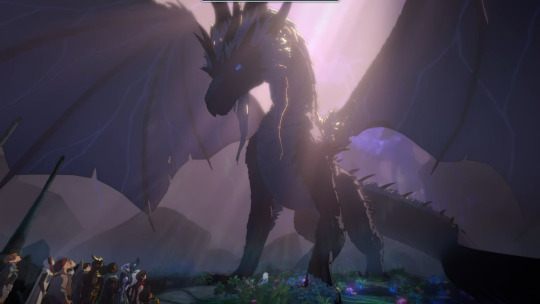


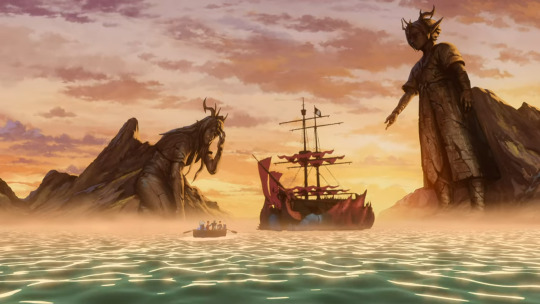
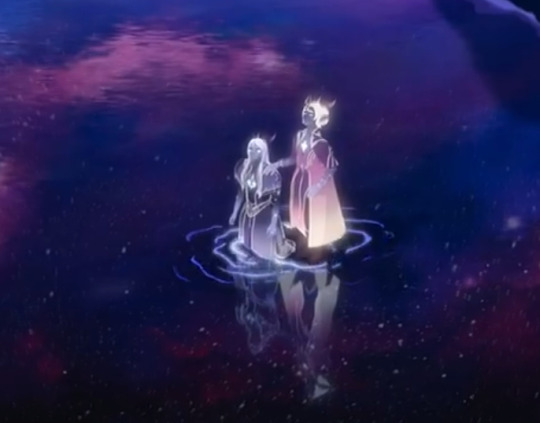
TDP likes to look at the act of changing the reality of a real moment and creating a new reality whose purpose is to be perceived by the masses. It fits very nicely with the framing that individual perspectives are inherently limited, and no one has the full story - but that this does not automatically make anyone "evil." But it's very much its own concept, too.
In these above examples where we get to see both the reality and the art that it inspired, changing even something as simple as the poses or clothing of those involved shifts the focus from the authenticity of the moment itself to a curated narrative that is deliberately chosen for its own purpose. An artificially altered perspective that is intended for many to share.
There's a meta layer to this as well. The Dragon Prince itself is deliberately created, of course. And within the art of the show, it is choosing to hold a mirror up to itself with all this in-universe art, and how it is not a perfect reflection of reality. Fiction is always a carefully crafted universe of its own.
So, why did TDP choose the alterations it did? And why did it deliberately draw our attention to those changes through this repeated altered-art motif?
Art is neutral. Art is a medium. It can be used for good or ill, depending on the intent of those who create and distribute it. Are we to look at every example of art taken from historical events in TDP and question whether it really happened the way they're portraying it?
Yes.
Are we to look at real Earth history itself this way, and all the art it has spawned in the real world?
Absolutely.
Fiction is an imperfect mirror on purpose. That is the entire point of fiction: that it is not reality, but it is close enough to make us think twice.
Or at least once. Bare minimum.
Personally, I'm really curious what the reality was behind this art installation:

Maybe we'll find out someday.
#tdp#tdp meta#tdp spoilers#art meta#mmm this is so fun#it's nice to see some xadian representation of this motif finally#i want a giant overly pompous statue of runaan please#like his official bio pose or something#ponytail in the wind and eyes on the horizon#just dramatic af for no reason#and then there's everyday runaan who beams at beige bittersquashes in the market
67 notes
·
View notes
Text
The Chris and water theming is still making itself known.
It’s making me wonder if that pool is gonna get built and Chris is gonna get into danger in it because Helena isn’t paying attention etc!
#Eddie feeling inferior because he can’t provide a swimming pool - a small man made body of water full of chemicals - something fake#when he has an entire ocean on the door step that Christopher and he are shown to spend a lot of time at and in#the biggest body of water on the planet - with no chemicals just salt (which I know is technically a chemical but it’s naturally occurring#and we’re not talking about pollution)#it’s chemical v natural and fake v genuine and small and constraining v wide and open#it’s a metaphor for what Helena provides as a parent v what Eddie does#Helena is constrained and formulaic and narrowing Christopher’s horizons like she did Eddie’s#where as Eddie has and is giving his son all the space and far reaching horizons - endless opportunities#911 spoilers#eddie diaz#christopher diaz#anti Helena diaz#911 abc#911 meta#water theming my beloved
35 notes
·
View notes
Text
The story that the Matriarch is telling seems to be akin to a creation myth, a more esoteric explanation of how the world came to be. The "faithless" appears to be the broader term of anyone who isn't considered Nora or proto-Nora; an explanation as to the existence of people outside the Embrace. A "they had to come from somewhere, so they must have come from here" kind of situation.
The Nora creation myth is definitely a establishment of the values they hold (do not worship metal; it caused the downfall of all others), what separates them from the perceived out-groups (the "true people" live only within the Embrace, all others are "faithless"), and tenets that reinforce the community in a tribal setting (All-Mother provided for us this world we build and uphold with our own hands).
The thing I am most interested in is the recall and dissemination of history of the Nora compared to the Carja, since the former has oral traditions which can only be found in specific incidences, whereas the Carja , with their written records, have much more accessible reference. The history of these two tribes in intertwined in a way that none of the others can really compare to, having become two entirely separate and distinct tribal group -- quite unlike the Tenakth who merely split into different clans under one tribe.
The sixth Scanned Glyphs datapoint titled The Founding of Meridian details Araman finding the "Leaves of the Old Ones", and that the glyphs they now use came from those writings, used so "our knowledge could last longer than our voices". It explicitly details that they left the "Savage East"; terminology they still use in contempt of the Nora now. As important foundational history to their tribe, the Carja clearly have included this significant event in the telling of who they are as a tribe and how they came to be; the Nora, even in ambient dialogue, do not refer to the Carja as much more than "slavers and killers".
The Carja split from the Nora is reasonably well within the last hundred or so years: if the Carja have existed for, say, 100 years, the average reign of the previous thirteen Sun-Kings is 7.7 years -- removing Avad from the calculation due to an exact number of years of his reign being known (3 years) from Scanned Glyph datapoints (Record of Redmaw 1 and 2). Most notable events occur in the 4th, 7th, or 8th year of past Sun-Kings (datapoints: History of Sunfall, Legendary Hunts) so even 150 years of the Carja's tribal existence averages around 11.5 years per king, and within a reasonable timeline. The Carja-Nora split would then theoretically be within a few generations of the current High Matriarchs' lifespan, so the stories would be relatively new in their oral history. This notable event of a mass exodus, alongside the later years of the Red Raids, would presumably produce more stories of warning against the Carja -- blasphemers who ventured into forbidden metal ruins, who became misled by taboo items and abandoned the faith and care of All-Mother to wander the Tainted Lands, only to return to the lands they left seeking blood and bloodshed decades later.
Even with Aloy's outcast upbringing excusing limited access to history, there should be more evidence as to ill-will or mistrust of the Carja by the Nora beyond just the Red Raids. Superstitions, stereotypes, phrases of contempt or idiomatic warnings. Oral history has the caveat of not being as reliable as written records, so it stands to reason that there is a chance that the history of the Carja-Nora split was not passed down, either by deliberate omission to some degree, or a generational gap of Matriarchs dead from the Raids and therefore unable to pass on their history.
I just have so many questions about tribal lore. We know from Carja glyphs that they left the Nora and followed Araman west out of the mountains, but what do the Nora tell the younger generations of that split in the tribe?
It's all oral tradition, and mainly about All-Mother and the warnings of the Old World and the Metal Ruins. Was the story of half the tribe leaving omitted from the Nora oral history? If so, why?
Did the split contribute to the declaration of the Sacred Lands and enforcement of the border and rules of exile and outcasting?
Will we get to go back to Nora lands to find out more? There's so many loose ends there, still, I feel. I want to go back and at least see Sona again.
#cor talks#cor's meta analysis#horizon zero dawn#hzd#horizon meta#nora#carja#horizon tribal lore and meta
51 notes
·
View notes
Text
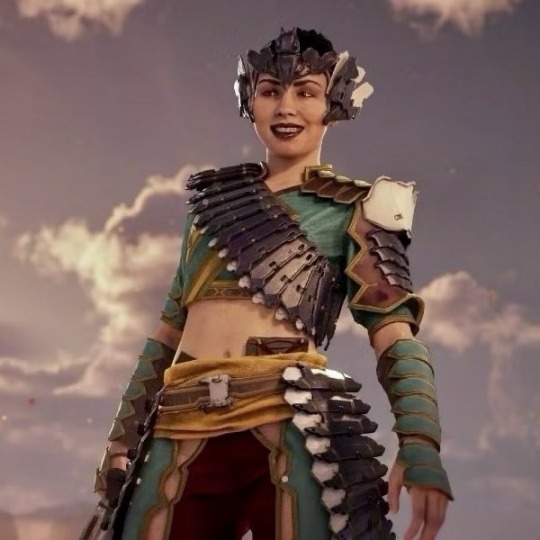
happy Lesbian Visibility Week to her! hope the Masterdoc was preserved in APOLLO because hoo boy does she need it
#I am going to make that big Comphet Talanah meta post soon#that’s a whole lesbian#you and Ben can pry that headcanon from my cold dead hands#horizon forbidden west#talanah khane padish
37 notes
·
View notes